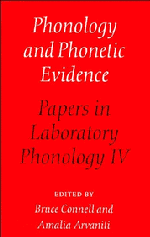Book contents
- Frontmatter
- Contents
- List of contributors
- Acknowledgments
- 1 Introduction
- I Features and Perception
- 2 Intermediate properties in the perception of distinctive feature values
- 3 A double-weak view of trading relations: comments on Kingston and Diehl
- 4 Speech perception and lexical representation: the role of vowel nasalization in Hindi and English
- 5 Processing versus representation: comments on Ohala and Ohala
- 6 On the status of redundant features: the case of backing and rounding in American English
- 7 The perceptual basis of some sound patterns
- II Prosody
- III Articulatory Organization
- Subject index
- Index of names
- Index of languages
4 - Speech perception and lexical representation: the role of vowel nasalization in Hindi and English
Published online by Cambridge University Press: 03 May 2011
- Frontmatter
- Contents
- List of contributors
- Acknowledgments
- 1 Introduction
- I Features and Perception
- 2 Intermediate properties in the perception of distinctive feature values
- 3 A double-weak view of trading relations: comments on Kingston and Diehl
- 4 Speech perception and lexical representation: the role of vowel nasalization in Hindi and English
- 5 Processing versus representation: comments on Ohala and Ohala
- 6 On the status of redundant features: the case of backing and rounding in American English
- 7 The perceptual basis of some sound patterns
- II Prosody
- III Articulatory Organization
- Subject index
- Index of names
- Index of languages
Summary
Introduction
The theory of underspecificationof lexical representation maintains that the stored form of words omits any predictable or nondistinctive information (Archangeli, 1988). As a data compression technique, there is no dispute that lexical storage can be minimized via underspecification. However, this leaves open the question of whether underspecification corresponds to how words are represented in speakers' mental lexicons. There have been various attempts to gather empirical evidence on the issue (Davidsen-Neilsen, 1975; Keating, 1988; Conn, 1990; Choi, 1992; Stemberger, 1991, 1992). A recent attempt of this sort was made by Lahiri & Marslen-Wilson (1991, 1992; henceforth L&MW) and Lahiri (1991) who looked to speech perception as a domain where underspecification might be validated. In this paper we summarize their experiment and report our attempt to replicate it.
L&MW suggested that the underlying lexical representations posited by phonologists “correspond, in some significant way, to the listener's mental representation of lexical forms … and that these representations have direct consequences for the way … the listener interprets the incoming acoustic-phonetic information” (1992: 229). Lahiri (1991: 385) argued specifically that “the surface structures derived after postlexical spreading do not play a distinctive role in perception; rather, a more abstract underspecified representation determines the interpretation of a phonetic cue.”
L&MW investigated Bengali and English listeners' identification of syllables in their respective languages which had had varying amounts of their terminal portions gated out. Of interest was their reaction to the presence or absence of nasalization on the vowels heard without the following consonant.
- Type
- Chapter
- Information
- Phonology and Phonetic EvidencePapers in Laboratory Phonology IV, pp. 41 - 60Publisher: Cambridge University PressPrint publication year: 1995
- 17
- Cited by



